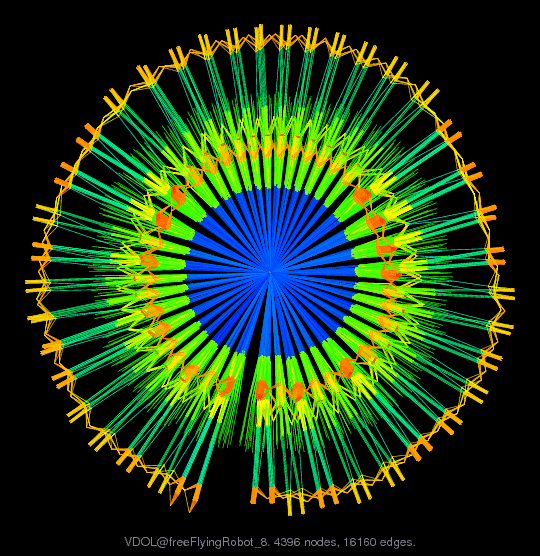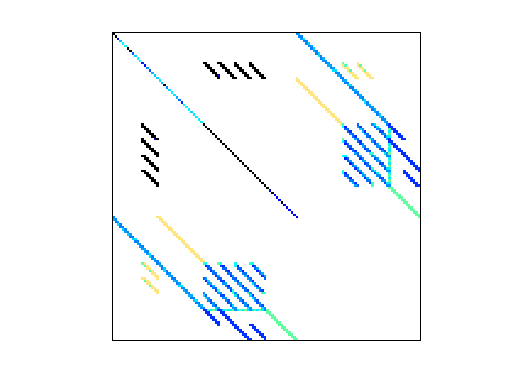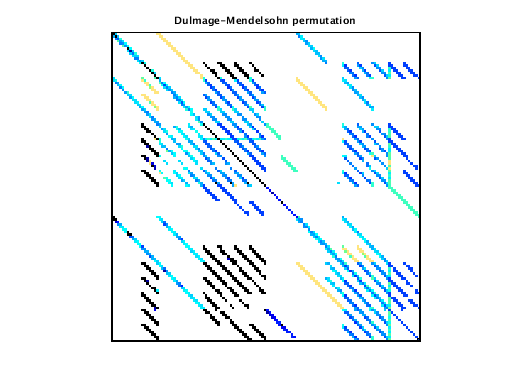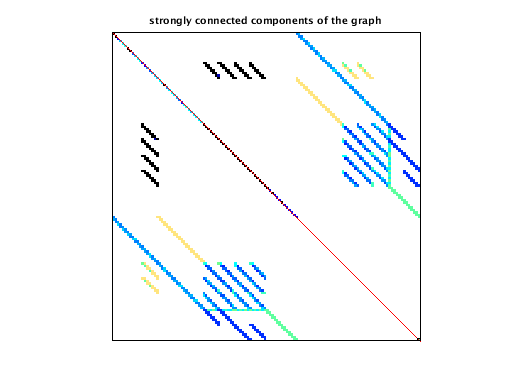
Matrix: VDOL/freeFlyingRobot_8
Description: freeFlyingRobot optimal control problem (matrix 8 of 16)
 |
| (undirected graph drawing) |
 |
 |
 |
| Matrix properties | |
| number of rows | 4,398 |
| number of columns | 4,398 |
| nonzeros | 34,958 |
| structural full rank? | yes |
| structural rank | 4,398 |
| # of blocks from dmperm | 3 |
| # strongly connected comp. | 2 |
| explicit zero entries | 0 |
| nonzero pattern symmetry | symmetric |
| numeric value symmetry | symmetric |
| type | real |
| structure | symmetric |
| Cholesky candidate? | no |
| positive definite? | no |
| author | B. Senses, A. Rao |
| editor | T. Davis |
| date | 2015 |
| kind | optimal control problem |
| 2D/3D problem? | no |
| Additional fields | size and type |
| b | full 4398-by-1 |
| rowname | full 4398-by-101 |
| mapping | full 4398-by-1 |
Notes:
Optimal control problem, Vehicle Dynamics & Optimization Lab, UF
Anil Rao and Begum Senses, University of Florida
http://vdol.mae.ufl.edu
This matrix arises from an optimal control problem described below.
Each optimal control problem gives rise to a sequence of matrices of
different sizes when they are being solved inside GPOPS, an optimal
control solver created by Anil Rao, Begum Senses, and others at in VDOL
lab at the University of Florida. This is one of the matrices in one
of these problems. The matrix is symmetric indefinite.
Rao, Senses, and Davis have created a graph coarsening strategy
that matches pairs of nodes. The mapping is given for this matrix,
where map(i)=k means that node i in the original graph is mapped to
node k in the smaller graph. map(i)=map(j)=k means that both nodes
i and j are mapped to the same node k, and thus nodes i and j have
been merged.
This matrix consists of a set of nodes (rows/columns) and the
names of these rows/cols are given
Anil Rao, Begum Sense, and Tim Davis, 2015.
VDOL/freeFlyingRobot
Free flying robot optimal control problem is taken from
Ref.~\cite{sakawa1999trajectory}. Free flying robot technology is
expected to play an important role in unmanned space missions.
Although NASA currently has free flying robots, called spheres,
inside the International Space Station (ISS), these free flying
robots have neither the technology nor the hardware to complete
inside and outside inspection and maintanance. NASA's new plan is to
send new free flying robots to ISS that are capable of completing
housekeeping of ISS during off hours and working in extreme
environments for the external maintanance of ISS. As a result, the
crew in ISS can have more time for science experiments. The current
free flying robots in ISS works are equipped with a propulsion
system. The goal of the free flying robot optimal control problem is
to determine the state and the control that minimize the magnitude of
thrust during a mission. The state of the system is defined by the
inertial coordinates of the center of gravity, the corresponding
velocity, thrust direction, and the anglular velocity and the control
is the thrust from two engines. The specified accuracy tolerance of
$10^{-6}$ were satisfied after eight mesh iterations. As the mesh
refinement proceeds, the size of the KKT matrices increases from 798
to 6078.
| Ordering statistics: | result |
| nnz(chol(P*(A+A'+s*I)*P')) with AMD | 42,828 |
| Cholesky flop count | 6.0e+05 |
| nnz(L+U), no partial pivoting, with AMD | 81,258 |
| nnz(V) for QR, upper bound nnz(L) for LU, with COLAMD | 1,352,402 |
| nnz(R) for QR, upper bound nnz(U) for LU, with COLAMD | 2,847,313 |
For a description of the statistics displayed above, click here.
Maintained by Tim Davis, last updated 04-Jun-2015.
Matrix pictures by cspy, a MATLAB function in the CSparse package.
Matrix graphs by Yifan Hu, AT&T Labs Visualization Group.